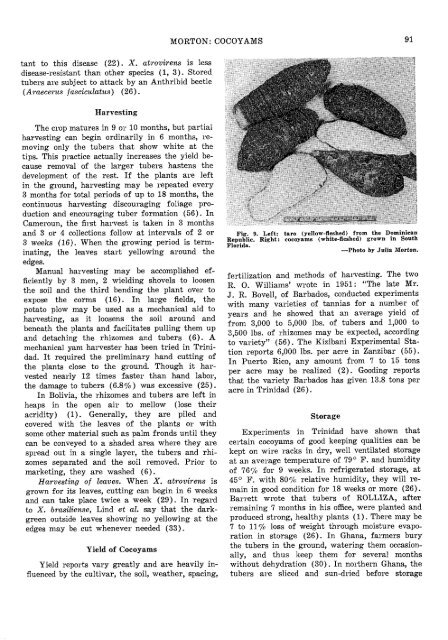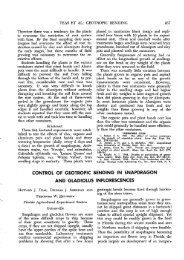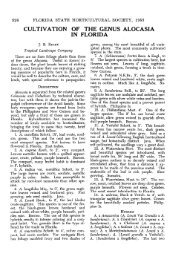(xanthosoma caracu, x. atrovirens and x. nigrum), ancient root
(xanthosoma caracu, x. atrovirens and x. nigrum), ancient root
(xanthosoma caracu, x. atrovirens and x. nigrum), ancient root
You also want an ePaper? Increase the reach of your titles
YUMPU automatically turns print PDFs into web optimized ePapers that Google loves.
tant to this disease (22). X. <strong>atrovirens</strong> is less<br />
disease-resistant than other species (1, 3). Stored<br />
tubers are subject to attack by an Anthribid beetle<br />
(Araecerus fasciculatus) (26).<br />
Harvesting<br />
The crop matures in 9 or 10 months, but partial<br />
harvesting can begin ordinarily in 6 months, re<br />
moving only the tubers that show white at the<br />
tips. This practice actually increases the yield be<br />
cause removal of the larger tubers hastens the<br />
development of the rest. If the plants are left<br />
in the ground, harvesting may be repeated every<br />
3 months for total periods of up to 18 months, the<br />
continuous harvesting discouraging foliage pro<br />
duction <strong>and</strong> encouraging tuber formation (56). In<br />
Cameroun, the first harvest is taken in 3 months<br />
<strong>and</strong> 3 or 4 collections follow at intervals of 2 or<br />
3 weeks (16). When the growing period is term<br />
inating, the leaves start yellowing around the<br />
edges.<br />
Manual harvesting may be accomplished ef<br />
ficiently by 3 men, 2 wielding shovels to loosen<br />
the soil <strong>and</strong> the third bending the plant over to<br />
expose the corms (16). In large fields, the<br />
potato plow may be used as a mechanical aid to<br />
harvesting, as it loosens the soil around <strong>and</strong><br />
beneath the plants <strong>and</strong> facilitates pulling them up<br />
<strong>and</strong> detaching the rhizomes <strong>and</strong> tubers (6). A<br />
mechanical yam harvester has been tried in Trini<br />
dad. It required the preliminary h<strong>and</strong> cutting of<br />
the plants close to the ground. Though it har<br />
vested nearly 12 times faster than h<strong>and</strong> labor,<br />
the damage to tubers (6.8%) was excessive (25).<br />
In Bolivia, the rhizomes <strong>and</strong> tubers are left in<br />
heaps in the open air to mellow (lose their<br />
acridity) (1). Generally, they are piled <strong>and</strong><br />
covered with the leaves of the plants or with<br />
MORTON: COCOYAMS<br />
some other material such as palm fronds until they<br />
can be conveyed to a shaded area where they are<br />
spread out in a single layer, the tubers <strong>and</strong> rhi<br />
zomes separated <strong>and</strong> the soil removed. Prior to<br />
marketing, they are washed (6).<br />
Harvesting of leaves. When X. <strong>atrovirens</strong> is<br />
grown for its leaves, cutting can begin in 6 weeks<br />
<strong>and</strong> can take place twice a week (29). In regard<br />
to X. brasiliense, Lind et al. say that the dark-<br />
green outside leaves showing no yellowing at the<br />
edges may be cut whenever needed (33).<br />
Yield of Cocoyams<br />
Yield reports vary greatly <strong>and</strong> are heavily in<br />
fluenced by the cultivar, the soil, weather, spacing,<br />
Fig. 9. Left: taro (yellow-fleshed) from the Dominican<br />
Republic. Right: cocoyams (white-fleshed) grown in South<br />
Florida.<br />
—Photo by Julia Morton.<br />
fertilization <strong>and</strong> methods of harvesting. The two<br />
R. 0. Williams' wrote in 1951: "The late Mr.<br />
J. R. Bovell, of Barbados, conducted experiments<br />
with many varieties of tannias for a number of<br />
years <strong>and</strong> he showed that an average yield of<br />
from 3,000 to 5,000 lbs. of tubers <strong>and</strong> 1,000 to<br />
3,500 lbs. of rhizomes may be expected, according<br />
to variety" (56). The Kizibani Experimental Sta<br />
tion reports 6,000 lbs. per acre in Zanzibar (55).<br />
In Puerto Rico, any amount from 7 to 15 tons<br />
per acre may be realized (2). Gooding reports<br />
that the variety Barbados has given 13.8 tons per<br />
acre in Trinidad (26).<br />
Storage<br />
Experiments in Trinidad have shown that<br />
certain cocoyams of good keeping qualities can be<br />
kept on wire racks in dry, well ventilated storage<br />
at an average temperature of 79° F. <strong>and</strong> humidity<br />
of 76% for 9 weeks. In refrigerated storage, at<br />
45° F. with 80% relative humidity, they will re<br />
main in good condition for 18 weeks or more (26).<br />
Barrett wrote that tubers of ROLLIZA, after<br />
remaining 7 months in his office, were planted <strong>and</strong><br />
produced strong, healthy plants (1). There may be<br />
7 to 11% loss of weight through moisture evapo<br />
ration in storage (26). In Ghana, farmers bury<br />
the tubers in the ground, watering them occasion<br />
ally, <strong>and</strong> thus keep them for several months<br />
without dehydration (30). In northern Ghana, the<br />
tubers are sliced <strong>and</strong> sun-dried before storage<br />
91





